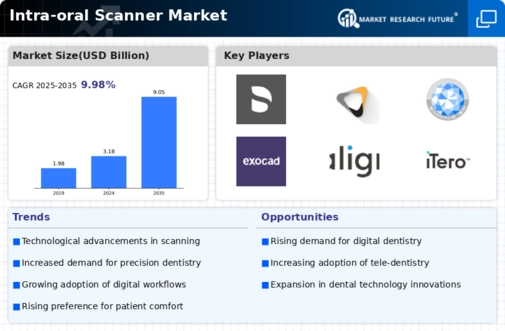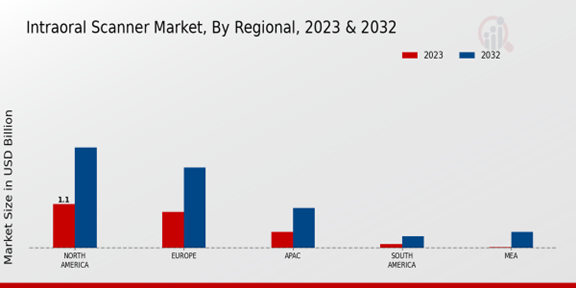Market Growth Projections
Rising Aesthetic Dentistry
The growing emphasis on aesthetic dentistry significantly influences the Global Intra-oral Scanner Market Industry. Patients increasingly seek cosmetic dental procedures, which require precise imaging and planning. Intra-oral scanners facilitate this by providing high-resolution images that aid in the design of custom restorations and orthodontic treatments. As aesthetic procedures gain popularity, the demand for intra-oral scanners is expected to rise correspondingly. This trend is indicative of a broader shift in patient expectations, where the quality of dental care is increasingly linked to technological capabilities. Thus, the market is poised for substantial growth as aesthetic dentistry continues to expand.
Technological Advancements
The Global Intra-oral Scanner Market Industry is experiencing rapid technological advancements that enhance the accuracy and efficiency of dental procedures. Innovations such as improved imaging capabilities and faster scanning processes are becoming commonplace. For instance, the introduction of 3D imaging technology allows for more precise diagnostics and treatment planning. These advancements not only streamline workflows but also improve patient outcomes, making intra-oral scanners more appealing to dental practitioners. As a result, the market is projected to grow from 3.18 USD Billion in 2024 to 9.05 USD Billion by 2035, indicating a robust demand driven by technological progress.
Growing Geriatric Population
The increasing geriatric population is a significant driver for the Global Intra-oral Scanner Market Industry. As individuals age, they often require more dental care, including restorative and preventive treatments. Intra-oral scanners are particularly beneficial for this demographic, as they provide quick and comfortable imaging solutions. The rising number of elderly patients seeking dental services is expected to boost the demand for intra-oral scanners, as practitioners look for efficient ways to cater to this population. This trend underscores the importance of adapting dental practices to meet the needs of an aging society, thereby fostering market growth.
Government Initiatives and Funding
Government initiatives aimed at improving healthcare infrastructure play a crucial role in the Global Intra-oral Scanner Market Industry. Various countries are investing in advanced dental technologies to enhance patient care and streamline dental practices. For example, funding programs that support the acquisition of digital equipment, including intra-oral scanners, are becoming more prevalent. These initiatives not only promote the adoption of modern dental technologies but also ensure that practitioners have access to the latest tools. As a result, the market is likely to benefit from increased investments in dental technology, further driving growth and innovation in the sector.
Increasing Demand for Digital Dentistry
The shift towards digital dentistry is a notable driver in the Global Intra-oral Scanner Market Industry. As dental professionals increasingly adopt digital solutions for diagnostics and treatment, intra-oral scanners have become essential tools. This trend is fueled by the growing awareness among patients regarding the benefits of digital impressions, such as reduced discomfort and improved accuracy. The market is likely to see a compound annual growth rate of 9.98% from 2025 to 2035, reflecting the rising preference for digital workflows in dental practices. Consequently, this demand is reshaping the landscape of dental care, making intra-oral scanners indispensable.













